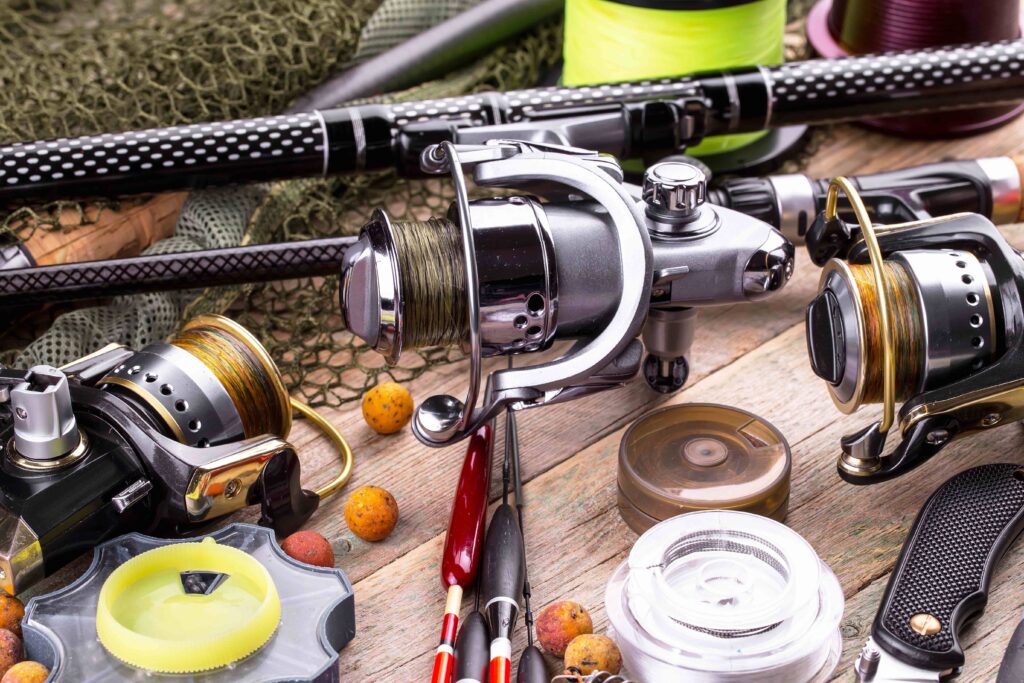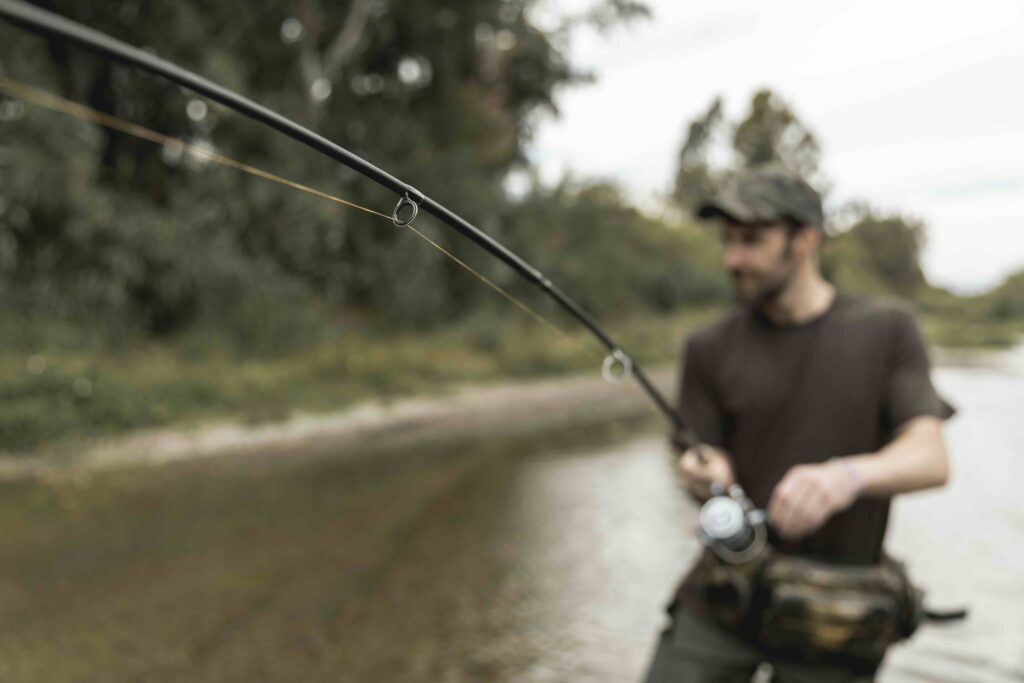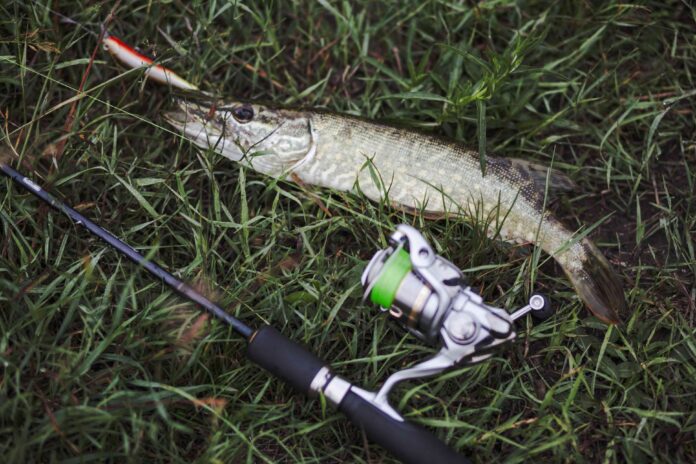The Thrill of Catching a Trout
There’s nothing quite like the feeling of reeling in a big, beautiful trout. The rush of adrenaline as you feel the tug on your line, the excitement as you see the fish leap out of the water, and the satisfaction of finally landing it after a tough fight – these are all part of what makes trout fishing such an amazing experience. But let’s be honest – catching trout isn’t always easy.
It takes skill, knowledge, and patience to consistently land these elusive fish. That’s why I’ve put together this guide to help you hone your skills and improve your chances of success on the water.
Essential Skills and Strategies for Trout Fishing
In this article, I’ll be covering all the essential skills and strategies you need to know to be a successful trout angler. Whether you’re completely new to fishing or you’re an experienced angler looking to up your game, there will be something in here for you.
First up, we’ll cover some basics like equipment selection (rods, reels, lines, lures), choosing good fishing spots based on weather conditions and geography (streams vs lakes), casting techniques (overhand vs sidearm), and retrieving methods. Next up is understanding trout behavior – knowing where they are likely to be found based on water conditions and temperature changes.
This is critical information because it helps anglers identify hotspots that are worth their time targeting for potential bites. We’ll also go into detail about different types of bait/lures that work well for various species & sizes of trout including dry flies, nymphs & streamers used in fly fishing or spinners & spoons used in spin-fishing setups.
but certainly not least come advanced strategies like drift fishing techniques or using a float tube / kayak to get deeper into the water. You’ll learn how to fish in difficult conditions like fast-moving streams or deep pools, and you’ll get some insider tips from experienced anglers who know how to lure in the big ones.
Preview of Main Sections
So now that you know what we’ll be covering, let’s take a closer look at the main sections of this article. In section 2, we’ll go over all the gear (rods, reels, lines, and lures) you need for trout fishing and discuss how to choose the best equipment for your needs. In section 3, we’ll dive into understanding trout behavior – where they live and feed based on their size & species.
We will also explore weather and water conditions that affect trout behavior. In section 4, we will focus on different techniques – fly fishing vs spin-fishing vs trolling- as well as share some tips for casting and retrieving bait effectively.
In section 5 – Advanced Strategies – we will discuss more advanced tactics like drift fishing or using a float tube/kayak to access hard-to-reach areas. This is where things really get interesting – prepare yourself for some exciting new ideas that are sure to make your next outing more successful!
The Basics

Choosing the Right Equipment for Trout Fishing
One of the most important aspects of trout fishing is choosing the right equipment. A quality fishing rod and reel are essential for catching trout.
When looking for a rod, it’s important to consider its length, weight, and action. A longer rod gives you more
leverage and casting distance, while a shorter one allows more accuracy in tight spaces. Weight is also crucial since lighter rods can’t handle heavier fish and vice versa. When it comes to reels, there are two main types: spinning reels and baitcasting reels.
Spinning reels are easier to use but don’t allow for as much control over the line as baitcasting ones do. It’s important to match your reel with your rod and line weight so that everything is balanced.
Choosing the right lures or bait is key to catching trout. Live bait such as worms or minnows can be effective but often require more skill to use than artificial lures like spinners or flies.
Finding the Perfect Spot
Once you have your equipment ready, you need to find a good spot to fish for trout. Look for areas with fast-moving water or where water falls into pools below rocks or logs – these spots usually attract hungry fish looking for insects drifting downstream.

Also consider factors like temperature – cold water holds more oxygen which means there will be more fish in cooler waters than warmer ones – as well as time of day- early morning or late evening are usually the most active times for trout. It’s also wise not to overlook smaller streams or creeks which may offer less competition from other anglers while still providing plenty of opportunities for landing prize trout.
Perfecting Your Cast and Retrieve
Casting accurately is another essential skill when it comes to catching trout. It’s important not only aim correctly but also to use the right amount of force. Overcasting can spook fish while too little can result in a poor presentation of the bait or lure.
Practice with a variety of weights and lines to find the perfect balance. When it comes to retrieving your lure, different techniques work better depending on the type of bait used and water conditions.
One popular method is to slowly reel in your line, pausing every so often to give the impression of natural movement. It’s also important to vary your retrieve style based on what you think trout will respond best to.
By mastering these basic skills and strategies, you’ll be well on your way to landing prize trout. Remember that practice makes perfect – keep experimenting and refining your techniques until you find what works best for you!
Understanding Trout Behavior
Trout Types and Habitats: Know Your Prey
It’s important for any angler to understand the different types of trout and their habitats. Brook trout, for example, prefer cool, clear streams with plenty of cover in the form of rocks and logs.
Brown trout, on the other hand, prefer deeper water with plenty of structure in the form of rocks and boulders. Rainbow trout can be found in a variety of habitats such as rivers, streams, lakes and even estuaries.
Another important consideration when it comes to trout habitat is water temperature. Trout are cold-water fish that are typically found in areas where water remains below 68°F (20°C) throughout most of the year.
The Weather Factor: How It Affects Trout Behavior
Weather conditions play a critical role in determining where fish will be located at any given time. For instance, overcast days often lead to increased feeding activity among trout because they feel more secure when there is reduced light penetration on the surface.
During periods of high pressure or bright sunshine, fish tend to retreat to deeper waters or seek shelter beneath structures such as rocks or logs. Conversely, low-pressure systems generally produce more active fishing due to increased cloud cover and precipitation that can stimulate feeding activity.
Reading Water: Strategies for Finding Fish
One key skill for successful trout fishing is being able to identify good fishing spots based on reading the water. Look for areas where there are natural obstructions such as rocks or logs that create eddies or pools which provide shelter for fish from strong currents.
Also look out for riffles – sections where fast-moving currents meet slower-moving ones – as these areas tend to offer ideal feeding grounds for trout since they bring nutrients downstream from upstream ecosystems. don’t forget about structure!
Trout love underwater structures such as drop-offs or weed beds that provide cover, shade and oxygen for them to thrive. By understanding these behaviors and habitats, you’ll be well on your way to landing the prize.
Techniques for Catching Trout
Different types of bait and lures that work well for trout fishing
When it comes to bait and lures, there are a ton of options out there for catching trout. But let me tell you, not all are created equal.
One tried and true method is using live bait such as worms or minnows. These are great for beginners as they are easy to use, readily available, and generally inexpensive.
They work best in slow-moving water such as streams or small rivers where the fish have time to investigate. Another option is using artificial lures such as spinners or spoons.
These imitate the movement of small prey fish and can really attract the attention of larger trout who are looking for a hearty meal. They work well in both slow and fast-moving water, making them a versatile choice.
Let’s talk about flies. Fly fishing is an art form that takes time to master but can be incredibly rewarding once you get the hang of it.
The key with flies is to match what the fish are naturally feeding on in their environment. This means researching what insects or other small creatures live in the water you’ll be fishing in and selecting a fly that closely resembles them.
Tips on how to use each type effectively
Now that we’ve covered some different types of bait and lures, let’s talk about how to use them effectively. When using live bait, it’s important to keep it fresh and lively so it appears more appetizing to the fish.
Use a hook size appropriate for your bait size so it doesn’t appear too big or too small compared to its surroundings. With artificial lures, success often lies in how convincingly you can make them move like real prey fish would move in the water.
Experiment with different retrieval speeds and motions until you find what works best in the particular water you’re fishing in. And don’t be afraid to switch up your lure if it’s not working – sometimes fish are picky and it takes a few tries to find what they’re biting on that day.
When it comes to fly fishing, practice makes perfect. It takes time and patience to learn how to cast a fly line effectively and present your fly in a way that looks natural to the fish.
Start with simpler patterns like dry flies or nymphs before moving on to more complex streamer patterns. And remember, fly fishing is not just about catching fish – it’s also about enjoying the beauty of nature and the challenge of mastering a new skill.
Different techniques such as fly fishing, spin fishing, trolling, etc.
There are many different techniques for catching trout, each with its own unique advantages and challenges. Fly fishing is often considered the most elegant and challenging method as it requires precise casting and presentation skills. Spin fishing is a popular choice for beginners as it’s easy to learn and can be effective in a variety of water conditions.
Trolling is another option that involves dragging lures behind a moving boat or float tube. This can be effective for covering large areas of water quickly but requires more equipment than other methods.
Drift fishing is another technique that involves allowing your bait or lure to drift naturally with the current while you stay stationary on shore or in a boat. This can be an effective way to cover lots of ground without having to constantly retrieve your line and recast.
Ultimately, the technique you choose will depend on factors such as your skill level, available equipment, and type of water you’ll be fishing in. Experiment with different methods until you find what works best for you – after all, half the fun of trout fishing is trying out new things!
Advanced Strategies: Mastering the Art of Trout Fishing
Drift Fishing: The Secret Technique to Landing Trophy Trout
If you’re looking for an advanced technique that separates the amateur from the pro, then you should master drift fishing. It’s a technique that’s been long used by experienced anglers to land trophy trout in fast-moving water. Drift fishing is all about using the current of the river to your advantage; it involves casting upstream and letting your bait or lure drift naturally with the flow of the water.
Here are some tips on how to effectively do drift fishing:
- Select a rod with a sensitive tip and good casting distance, this will help detect light bites in moving water.
- Use light line, preferably four-pound test line or less, as it will reduce drag and improve sensitivity
- Cast upstream and allow your bait or lure to float downstream with a natural presentation.
- If you feel a bite, don’t yank your rod back; instead, reel up any slack quickly until you feel tension on the line before setting the hook.
Fishing Deep Pools: Make Your Lure Stand Out
Fishing deep pools can be challenging yet rewarding. The key is finding where trout are holding in those deep pools. Look for cover such as rocks or logs where trout might be hiding from predators.
Here are some tips for fishing deep pools:
- Select lures that sink quickly such as jigs or soft plastics that mimic natural prey like worms, insects or small fish in deep waters.
- Use bright colors for lures so that they are more visible in murky waters.
- Try to bounce your lure off the bottom, as it will create a disturbance and attract fish.
Insider Secrets: Tips From Experienced Anglers
The best way to learn how to become an expert angler is by learning from experienced anglers. Here are some insider secrets shared by experienced trout fishermen:
- Learn how to tie good knots, as a bad knot can cost you a trophy trout.
- Be patient and persistent when fishing; it’s not uncommon for trout to take hours before biting.
- Trout are selective feeders; match the hatch by using lures that mimic the prey in the water.
Troubleshooting: Common Problems While Trout Fishing
Even the most seasoned trout fishermen run into problems while fishing. Here are some common issues and quick fixes:
- If your bait or lure keeps getting snagged on rocks or logs, try using lighter weights or changing your casting angle.
- If you’re not getting bites, try changing your lure or bait. Trout can be picky eaters; sometimes switching up lures can make all the difference.
- If you’re having trouble with casting, practice in open fields before heading out on the water. Remember to relax and use proper technique for better accuracy.
Conclusion: Becoming a Master Trout Fisherman
Fishing for trout is one of the most enjoyable outdoor activities there is – but it does require skill, patience and persistence. If you follow these tips, techniques and strategies then you’ll be well on your way to becoming a master trout fisherman.
Always remember, never give up and keep learning from experienced anglers. There are always new skills to learn and more trophies to catch.



